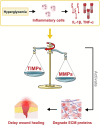Angiogenesis during diabetic wound repair: from mechanism to therapy opportunity
- PMID: 39927093
- PMCID: PMC11802347
- DOI: 10.1093/burnst/tkae052
Angiogenesis during diabetic wound repair: from mechanism to therapy opportunity
Abstract
Diabetes mellitus, a pervasive chronic metabolic disorder, is often associated with complications such as impaired wound healing. Various factors, most notably vascular deficiency, govern the wound repair process in diabetic patients, significantly impeding diabetic wound healing; therefore, angiogenesis and its role in diabetic wound repair have emerged as important areas of research. This review aims to delve into the mechanisms of angiogenesis, the effects of diabetes on angiogenesis, and the association between angiogenesis and diabetic wound repair. This will ultimately offer valuable guidance regarding the ideal timing of diabetic wound treatment in a clinical setting.
Keywords: Angiogenesis; Diabetes mellitus; Diabetic foot ulcers; Diabetic wound; Timing of treatment.
© The Author(s) 2025. Published by Oxford University Press.
Conflict of interest statement
None declared.
Figures





References
Publication types
LinkOut - more resources
Full Text Sources

